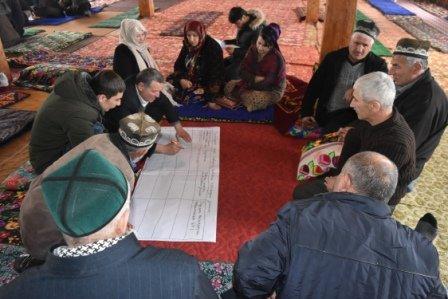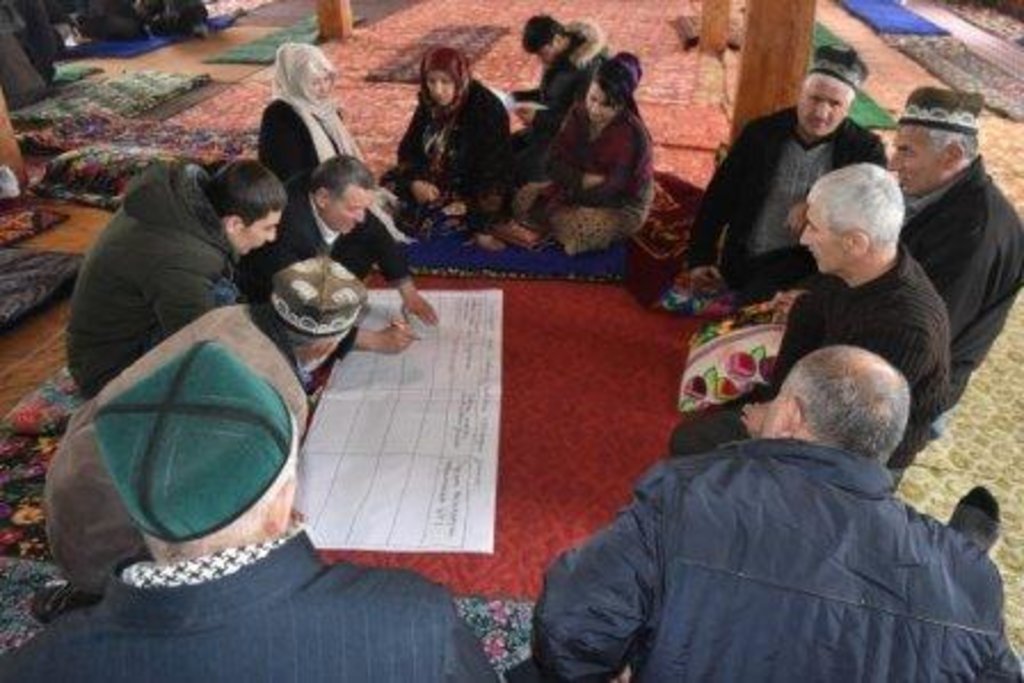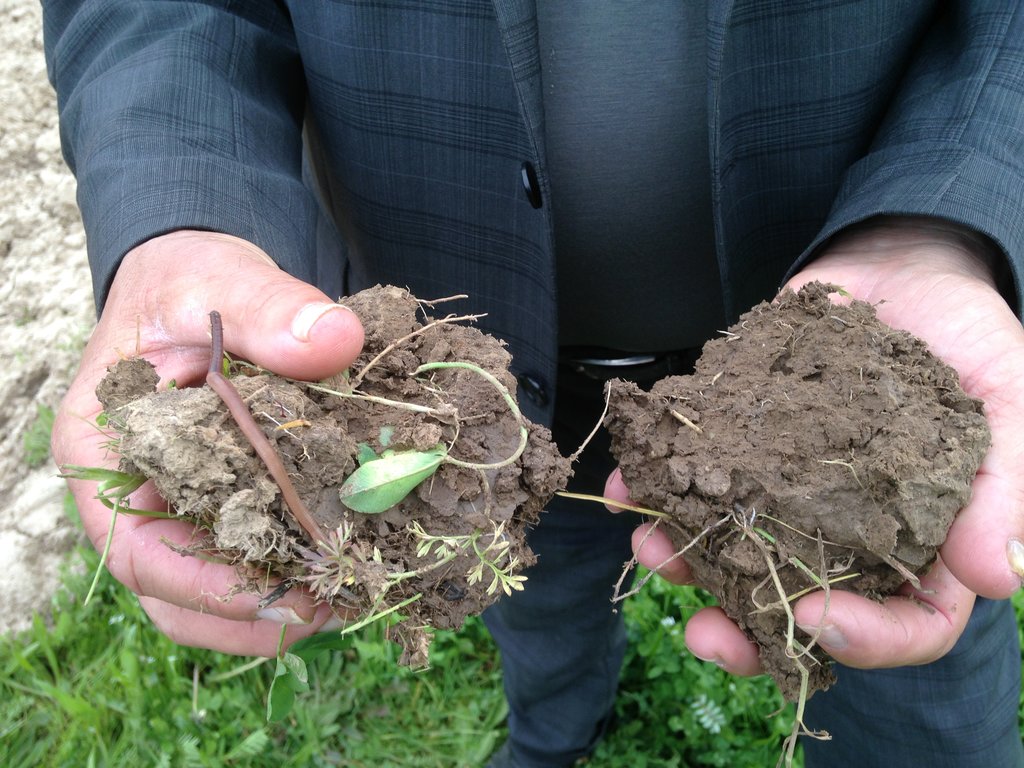Participatory Land use planning and assessment [طاجيكستان]
- تاريخ الإنشاء:
- تحديث:
- جامع المعلومات: Askarsho Zevarshoev
- المحرر: –
- المُراجع: Farrukh Nazarmavloev
Накшаи муштараки истифодабари ва бахогузории замин
approaches_3635 - طاجيكستان
عرض الأقسام
توسيع الكل طي الكل1. معلومات عامة
1.2 تفاصيل الاتصال بالأشخاص الرئيسيين لمصدر المعلومات والمؤسسات المعنية بتقييم وتوثيق النهج
اسم المشروع الذي سهّل توثيق/تقييم النهج (إذا كان ذلك على صلة)
Integrated Health and Habitat Improvement in Rasht Valley, Tajikistanاسم المؤسسة (المؤسسات) التي سهلت توثيق/تقييم النهج (إذا كان ذلك على صلة)
Aga Khan Foundation (AKF) - سويسرا1.3 الشروط المتعلقة باستخدام البيانات الموثقة من خلال WOCAT
متى تم تجميع البيانات (ميدانيا)؟:
25/07/2017
يوافق جامع المعلومات والشخص (لاشخاص) الرئيسي لمصدر المعلومات على الشروط المتعلقة باستخدام البيانات الموثقة من خلال WOCAT:
نعم
1.4 المراجع الخاصة باستبيان(استبيانات) تقنيات الإدارة المستدامة للأراضي
2. وصف نهج الإدارة المستدامة للأراضي
2.1 وصف موجز للنهج
Participatory Land Use Planning and Assessment is an inter disciplinary approach to the land use with combination of the modern tools and community knowledge to identify land degradations with its intensity and trends and through this approach design intervention directed toward land degradation prevention. This approach also compiles different tools including PRA and soil assessment and LADA techniques in a participatory manner. The approach address issues with all categories of land use including crop and pasture land, forest and even settlement with regards to natural disaster consideration for construction.
2.2 وصف تفصيلي للنهج
وصف تفصيلي للنهج:
As a precondition to the development of evidence- and needs-based plans, Participatory Land Use Planning and Assessment (PLUPA) will be conducted, with participation of local specialists, to assess sub-watershed natural and human-induced hazards and natural resource conditions, and IHA results will be presented to community and local government stakeholders to foster ownership. The outcome will improve community involvement in development by enhancing the ability to conduct local development planning and implementation.
Attention will be given to promoting the role of women in local development.
The PLUPA will employ terrestrial inspection of the land using simplified tools based on the WOCAT questionnaire for the land management technologies. The field-based assessment will include physical inspection of the land use and collecting necessary data like GPS points and information on target watershed (e.g. availability of pastureland, natural hazards, public and private infrastructure). The remote sensing component will be used for analyzing images and identification of trend analysis as well erosion on soil, land degradation.
Communities (via CSOs) and local governments are involved in conducting PLUPA, and will drive and own the result for development of their plan at watershed level. They will also be core stakeholders in the prioritization of water, health, and NRM interventions as per watershed management plan, and will be partners and contributors (including financially) in construction and management of new infrastructure post-project. This fosters commitment and ownership, promoting development that is accountable, participatory, inclusive, transparent, and efficient.
2.3 صور عن النهج
ملاحظات عامة بخصوص الصور:
Two sample of soils from one plot where the land used for different purposes
2.5 البلد/المنطقة/المواقع التي تم تطبيق النهج فيها
البلد:
طاجيكستان
Map
×2.6 تواريخ بدء وإنهاء تنفيذ النهج
في حالة عدم معرفة السنة بالتحديد، يرجى الإشارة إلى التاريخ التقريبي لبدء النهج:
منذ أقل من 10 سنوات (مؤخرًا)
2.7 نوع النهج
- قائم على مشروع/برنامج
2.8 الغايات/الأهداف الرئيسية للنهج
The main goal of the approach is to bring together stakeholders to use simplified methods on soil assessment and raise awareness on the importance of soil health for production. Based on that approach communities will design action for better management of their land and soil conservaiton
2.9 الظروف التي تمكن أو تعيق تنفيذ التقنية/التقنيات المطبقة بموجب النهج
المعايير والقيم الاجتماعية /الثقافية/ الدينية
- معيق
people are not organized well and land use planning is taking place on a add-hoc basis. traditional knowledge, which is bind to local culture and social norms is lost with applying pre-modern agriculture practice for what community does not have proper access to resources, such as inputs and tehcnology
الإطار المؤسساتي
- تمكين/تمكيني
الإطار القانوني (حيازة الأراضي، وحقوق استخدام الأراضي والمياه)
- تمكين/تمكيني
farmers are organized in a legal structure, which is make them compliant to the land rights and supported with planning for land use
المعرفة حول الإدارة المستدامة للأراضي، والوصول إلى الدعم الفني
- معيق
not all farmers, which got land have farming knowledge and practices on SLM. Basic practices which they learn from other farmer or inherited from their generation.
الأسواق (لشراء المدخلات وبيع المنتجات) والأسعار
- تمكين/تمكيني
there is a lot of demand for food products in the markets and existing service providers who supply inputs. If land use planning is organized in a good way community will get good benefit from farming.
3. المشاركة وأدوار الأطراف المعنية
3.1 أصحاب المصلحة المعنيون بالنهج وأدوارهم
- مستخدمو الأراضي المحليون/المجتمعات المحلية
land users, forest user, pasture users,
plan and provide field based knowledge on land use practices
- المنظمات المجتمعية
village organization and different initiative groups with regards to land use
support with mobilizing communities for better planning of the land resource and motivate collaboration between different land users
- متخصصون في الإدارة المستدامة للأراضي / مستشارون زراعيون
land management, forest, pasture specialist from related department of government
support with providing technical knowledge and solving the current land use issues with applying/providing good practices
- الحكومة المحلية
sub-district and district level
facilitate the process of collaboration among different land users and make decision on future perspective of land use
3.2 انخراط مستخدمي الأراضي المحليين/المجتمعات المحلية في المراحل المختلفة للنهج
| انخراط مستخدمي الأراضي المحليين/المجتمعات المحلية | حدد من شارك وصف الأنشطة | |
|---|---|---|
| المبادرة/التحفيز | الدعم الخارجي | land users of different categories, including pasture users, forest user etc,. come together to discuss the future land use perspective and decide on organizing themselves in better management of their land resources |
| التخطيط | تفاعلي | all stakeholders involved and support different perspective of land use categories and jointly plan for the future land use |
| التنفيذ | الدعم الخارجي | all stakeholders, involved in different land use categories negotiate and agree on terms and condition with regards complement the different land use importance. |
| الرصد/التقييم | سلبي | all stakeholders are passive in following the progress and results from land use intervention. |
3.4 اتخاذ القرار بشأن اختيار تقنية/تقنيات الإدارة المستدامة للأراضي
حدد من الذي قرر اختيار التقنية/التقنيات التي سيتم تنفيذها:
- متخصصون في الإدارة المستدامة للأراضي بشكل أساسي، بعد التشاور مع مستخدمي الأراضي
اشرح:
the approach is introduced in the framework of the projects and only SLM specialists consult on the tools and approach how to plan
حدد على أي أساس تم اتخاذ القرارات:
- تقييم المعرفة الموثقة جيدًا بشأن الإدارة المستدامة للأراضي(اتخاذ القرارات القائمة على الأدلة)
4. الدعم الفني وبناء القدرات وإدارة المعرفة
4.1 بناء القدرات/التدريب
هل تم تقديم التدريب لمستخدمي الأراضي / الأطراف المعنيين الآخرين؟:
نعم
حدد من تم تدريبه:
- مستخدمو الأراضي
- موظفون ميدانيون/ مستشارون
إذا كان ذلك على صلة، حدد الجنس والعمر والوضع والعرق وما إلى ذلك.
training on soil assessment, land management and participatory land use planning and assessment
شكل التدريب:
- في العمل
- اجتماعات عامة
المواضيع المغطاة:
land degradation, soil assessment, land management
4.2 خدمة استشارية
هل يملك مستخدمو الأراضي وصولا إلى خدمة استشارية؟:
كلا
4.3 تعزيز المؤسسات (التطوير التنظيمي)
هل تم إنشاء أو تعزيز مؤسسات من خلال هذا النهج؟:
- نعم، قليلا
حدد المستوى (المستويات) التي تم فيها تعزيز أو إنشاء المؤسسات:
- محلي
صف المؤسسة والأدوار والمسؤوليات والأعضاء وما إلى ذلك.
land use committee under the village organization as small entity dealing with land issues in the community only
حدد نوع الدعم:
- بناء القدرات/التدريب
اعط مزيدا من التفاصيل:
land management, land degradation prevention
4.4 الرصد والتقييم
هل يشكل الرصد والتقييم جزءا من النهج؟:
كلا
4.5 البحوث
هل كانت البحوث جزءًا من النهج؟:
كلا
5. التمويل والدعم المادي الخارجي
5.1 الميزانية السنوية لمكون الإدارة المستدامة للأراضي في النهج المذكور
إذا لم تكن الميزانية السنوية الدقيقة معروفة، قم بالإشارة إلى نطاقها:
- < 2000
5.2 الدعم المالي/المادي المقدم لمستخدمي الأراضي
هل حصل مستخدمو الأراضي على دعم مالي/ مادي لتنفيذ التقنية/ التقنيات؟:
كلا
5.3 إعانات لمدخلات محددة (بما في ذلك العمالة)
- غير موجود
إذا كان العمل من قبل مستخدمي الأراضي مدخلاً جوهريًا، فهل كان:
- تطوعي
5.4 الائتمان
هل تم توفير ائتمان في إطار نهج أنشطة الإدارة المستدامة للأراضي؟:
كلا
5.5 حوافز أو وسائل أخرى
هل تم استخدام حوافز أو أدوات أخرى لتشجيع تنفيذ تقنيات الإدارة المستدامة للأراضي؟:
نعم
إذا كانت الإجابة بنعم، حدد:
some funding was made available for implementation of action prioritized in the land use planning
6. تحليل الأثر والتصريحات الختامية
6.1 آثار النهج
هل ساهم النهج في تمكين مستخدمي الأراضي المحليين وتحسين مشاركة الأطراف المعنية؟:
- لا
- نعم، قليلا
- نعم، باعتدال
- نعم، إلى حد كبير
the process follow by series of capacity building trainings, which are empowering community to get knowledge and understanding
هل مكّن النهج من اتخاذ القرارات المبنية على الأدلة؟:
- لا
- نعم، قليلا
- نعم، باعتدال
- نعم، إلى حد كبير
as the approach involve participatory methods decision is made equally by all stockholders, including land users
هل ساعد النهج مستخدمي الأراضي على تنفيذ وصيانة تقنيات الإدارة المستدامة للأراضي؟:
- لا
- نعم، قليلا
- نعم، باعتدال
- نعم، إلى حد كبير
as a result of the approach action plan with implementing of technologies is involved
هل نجح النهج في تعبئة/تحسين الوصول إلى الموارد المالية لتنفيذ الإدارة المستدامة للأراضي؟:
- لا
- نعم، قليلا
- نعم، باعتدال
- نعم، إلى حد كبير
the approach results in a sophisticated document as plan and assessment report, which will then attracts funding for easy reference
هل ساهم النهج في التخفيف من حدة الصراعات؟:
- لا
- نعم، قليلا
- نعم، باعتدال
- نعم، إلى حد كبير
the plan is mobilize communities and other stakeholder to collaborate and work together and negotiate and resolve emerging conflicts over resource
6.2 المحفز الرئيسي لقيام مستخدمي الأراضي بتنفيذ الإدارة المستدامة للأراضي
- زيادة الإنتاج
prevention of and application of technologies contribute to improvement of production
- الحد من تدهور الأراضي
soil conservation techniques will be identified to apply for prevention of land degradation
6.3 استدامة أنشطة النهج
هل يمكن لمستخدمي الأراضي المحافظة على استدامة ما تم تنفيذه من خلال النهج (بدون دعم خارجي)؟:
- غير مؤكد
إذا كان الجواب لا أو غير متأكد، حدد ذلك وعلق عليه:
community are only focused to get maximum economic benefit from land and therefore do not pay enough attention to support ecosystem services or environmental aspect of land conservation
6.4 نقاط قوة/مزايا النهج
| نقاط القوة/ المزايا/ الفرص من وجهة نظر مستخدمي الأراضي |
|---|
| participatory |
| simply approach applied by community members themselve |
| نقاط القوة/ المزايا/ الفرص من وجهة نظر جامع المعلومات أو غيره من الاشخاص الرئيسيين لمصدر المعلومات |
|---|
| provides visions, empowers land users to negotiate interventions among them, also raise awareness on the sustainability aspects of land use and provides more aspects on land conservation techniques for land term land use |
6.5 نقاط الضعف/ العيوب في المنهج وطرق التغلب عليها
| نقاط الضعف/ المساوىء/ المخاطر من وجهة نظر مستخدم الأراضي | كيف يمكن التغلب عليها؟ |
|---|---|
| time consuming, required a lot of facilitation | more awareness on communities knowledge about long term land use benefits. strengthen local legal framework to sustain and promote the planing process |
| نقاط الضعف/ المساوىء/ المخاطر من وجهة نظر جامع المعلومات أو غيره من الاشخاص الرئيسيين لمصدر المعلومات | كيف يمكن التغلب عليها؟ |
|---|---|
| SLM knowledge and capacity | trainings for the local institutes involved in land use planing and management |
7. المراجع والروابط
7.1 طرق جمع/مصادر المعلومات
- زيارات ميدانية، مسوحات ميدانية
40
- مقابلات مع المتخصصين/الخبراء في الإدارة المستدامة للأراضي
3
7.2 المراجع للمنشورات المتاحة
العنوان، المؤلف، السنة، النظام القياسي الدولي لترقيم الكتب ISBN:
Participatory Land Use Planning, 2011
متاح من أين؟كم التكلفة؟:
Free of charge, from SLM compiler
الروابط والوحدات المواضيعية
توسيع الكل طي الكلالروابط
لا يوجد روابط
الوحدات المواضيعية
لا يوجد وحدات مواضيعية





